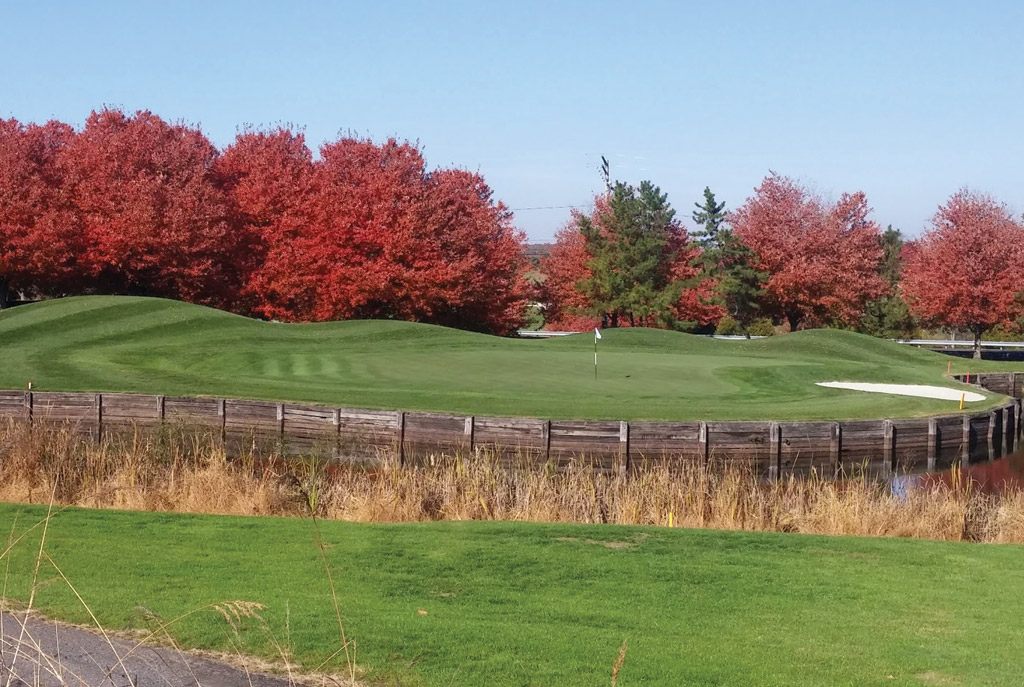[…]Considerations section and in the “Surface Water Management” section of this website. Best Management Practices Ensure that proper permitting has been obtained before working on designated tidal or nontidal wetlands or 100-year floodplains. Ensure that wetlands have been properly delineated before working in and around them. Next: […]
[…]danger to people or property. Construct and place birdhouses, bat houses, and nesting sites in out-of-play areas. Plant pollinator habitat in out-of-play areas or around the clubhouse. Retain riparian buffers along waterways to protect water quality and provide food, nesting sites, and cover for wildlife. Next: External Certification […]
[…]existing vegetation through the supplemental planting of native species next to long fairways, out-of-play areas, and water sources. Design out-of-play areas to retain or restore existing native vegetation where possible. Nuisance, invasive, and exotic plants should be removed and replaced with native species adapted to that particular site. Select a greens location that has adequate sunlight to meet plant-specific needs and that provides sufficient drainage. Choose a green size and sufficient number of hole locations that can accommodate traffic and play damage but are not so large that they are unsustainable. Select an appropriate root-zone material for the site. Consider […]
[…]to third internode and seedlings have reached a height of one-third greater than intended height-of-cut. This will hasten establishment. Next: Erosion and Sediment […]
[…]pollinator health as well as expanding habitat for pollinators. Priority topics addressed in this website and its companion document include the use of nutrients and pesticides, the potential for erosion and sedimentation, water conservation, and emerging concerns related to pollinators. Each area is described briefly below and addressed throughout this document. Nutrient and Pesticide Usage The proper use of nutrients and pesticides promotes healthy plant growth which then promotes ecosystem health. When applied properly and in the correct amounts, nutrients are taken up by plants and create a dense, healthy turf that resists diseases and weed encroachment. When properly applied, […]
[…]held, and finally leaves the property. In some instances, golf courses are mandated to handle a 20-, 50-, or 100-year rain event, which means the golf course must detain more water for perhaps a longer period of time. This ability to detain large amounts of water requires accurate engineering and extensive construction to prevent physical or financial damage to the facility. Many BMPs are intended to prolong the detention process as long as practical, retain as much of the stormwater in surface or underground storage as reasonable, and to improve the quality of water leaving the property when possible. Most […]
[…]Storage, and Security.” Maryland Pesticide Applicator Core Manual. pp. 124-135. Pesticide Information Leaflet No. 35: Synopsis of the Maryland Pesticide Applicators Law and Regulations. 2012. University of Maryland. Best Management Practices Maintain an inventory of all pesticides used and the SDS for each chemical. Avoid purchasing large quantities of pesticides that require storage for greater than six months. Adopt the “first in–first out” principle, using the oldest products first to ensure that the product shelf life does not expire. Store, mix, and load pesticides away from sites that directly link to surface water or groundwater. Store pesticides in a lockable […]
[…]state and NTEP test location. Maryland test results and recommendations can be found on the NTEP website. Recommendations for Maryland are also published and updated annually in Recommended Turfgrass Cultivars for Certified Sod Production and Seed Mixtures in Maryland. 2016. University of Maryland. When selecting cultivars for a specific site, considerations include the desired use, site and microclimate conditions, disease resistance, and spring transition traits. The Maryland Department of Agriculture administers the Maryland Certified Sod program. Certified sod must contain only the recommended cultivars. Requiring certified sod in specifications guarantees that the sod contains currently recommended cultivars, has been seeded in […]

